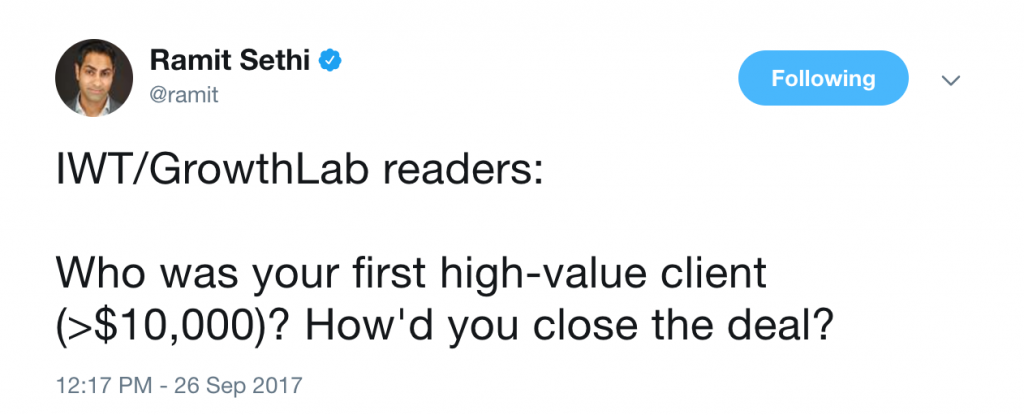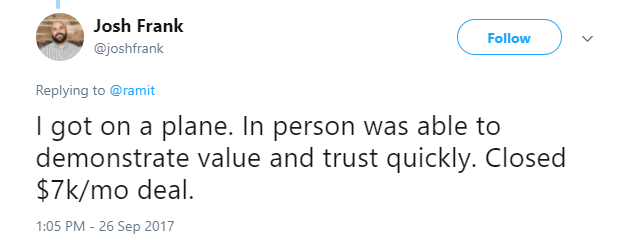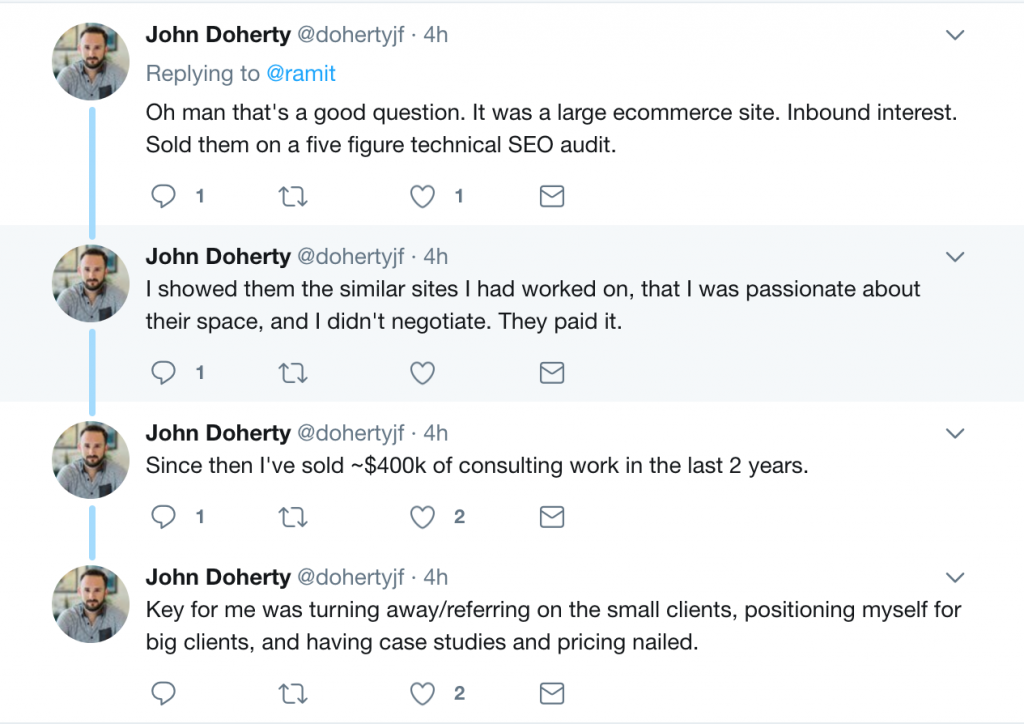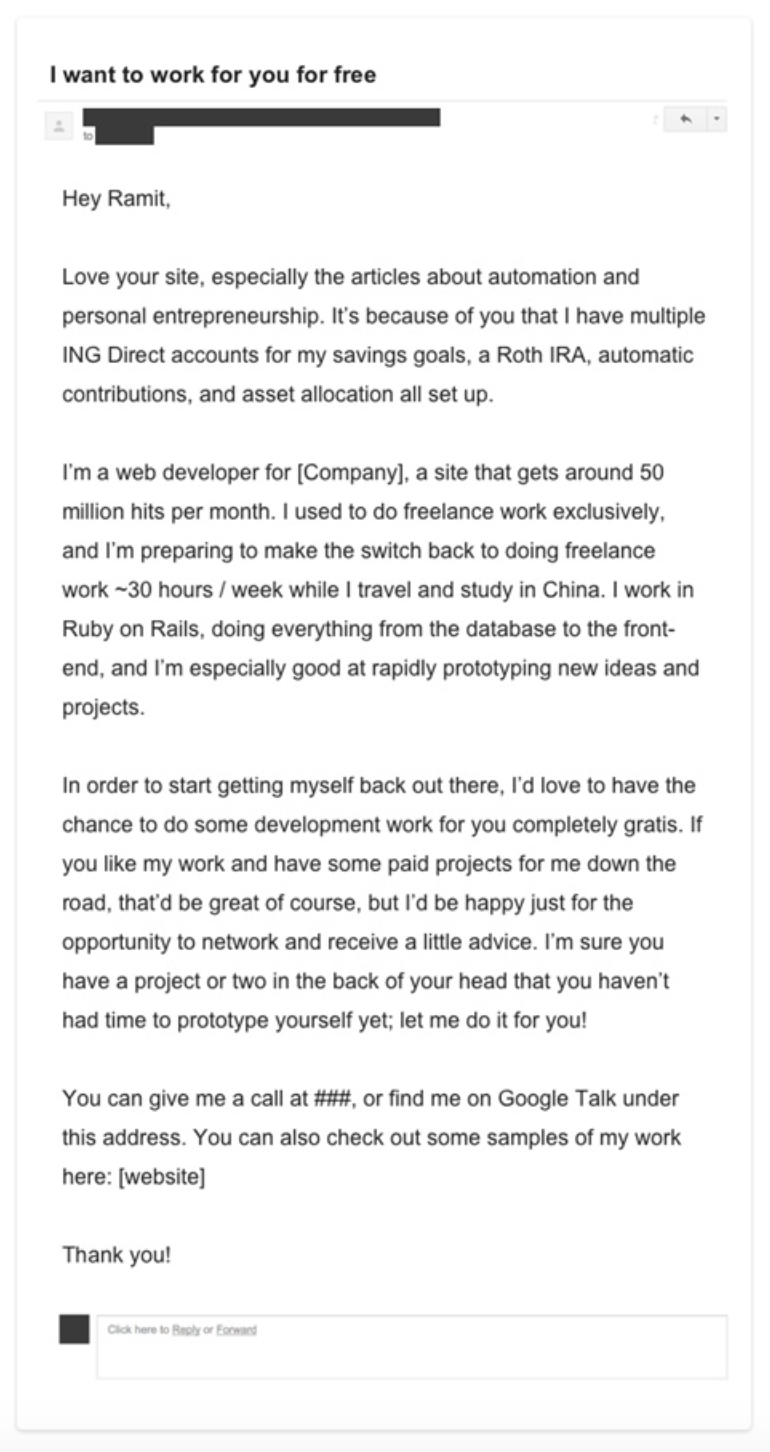If you’re looking to learn how to get clients online, the methods in this guide will help you start making more money fast. Whether you’re just starting out in consulting — full-time or side hustle — or your business is well underway and you’re looking to find higher-ticket gigs, these resources will help.
At IWT, we’ve helped thousands of students start their own businesses. A common question that lots of people have is how to get clients. So, we asked our students.

The answers we got back were amazing.



AWESOME.
If you want to be able to land the same kind of high-quality, high-paying clients, I’ll show you the best ways to find them and the best tactics and systems you can use that’ll have them watering at the mouths for your services.
And the best part about the people who replied to me on Twitter? None of the tactics they used were overly complex.
They didn’t rely on viral marketing campaigns or blogging or any of the other typical “advice” you find when looking up how to get clients — they demonstrated their value and closed the deal.
How to get your first client
When it comes to finding clients, new freelancers often don’t know where to start. It’s easy to think that every other online contractor quit their miserable job and is now making triple their salary working part-time from a café in Prague, that it can feel overwhelming.
However, Ramit’s answer to this is simply: Get one client.
Freelancers are so wrapped up in getting as many clients as possible as quickly as possible that they ignore the importance of attaining their first few clients and then scaling from there.
Utilize the resources below to find those first few.
1. Search industry-specific job boards
If perusing job search metasites like Indeed.com or SimplyHired for part-time contract work is not your thing, you might find more comfort with industry-specific job boards.
MarketingHire for marketers, the PMI’s Career Center for project managers, and other industry-specific sites listing jobs can hopefully deliver more relevant jobs.
However, no doubt, a Google search on job boards or sites for a particular role will at some point or another lead you to freelancer sites like Upwork or Fiverr. These types of sites are good for those either completely new to freelancing or completely new to offering a particular service (i.e., your day job is as a paralegal but you want to freelance as a fitness blogger).
Ramit loves sites like Upwork and Fiverr… but only as a client.
“I can get some of the best people online to do work for me at an extremely cheap rate on these sites. Sound unfair? Totally. But that’s the way it is.”
Ramit talks about all this and lots more in his FREE Official Handbook to 6-Figure Freelancing with Zero Experience.
2. Search Twitter to find clients in need of your services
Sure, you might find job postings tweeted out by job sites (follow the hashtag #jobs), but don’t just respond to those — go deeper.
Anyone who’s in the process of evaluating different products, including software — or perhaps gotten stuck using a product or software they already bought — will take to the interwebs to ask a question. Twitter is a great place for people to ask questions, and if you have expertise in a particular product, say accounting software, there’s no reason why you can’t find these questions and answer them.
Of course, you won’t want to give the most complete answer. For one, it might not fit within 280 characters, and two, you want the person to follow up with you via direct message or privately to discuss a potential project.
And who knows, one single answer tweet can help you land multiple customers.
3. Find clients on Craigslist
Craigslist gets a bum rap, and for good reason. (Thank goodness they kept the Best of Craigslist so we can all have a good laugh every so now and then.)
However, client work is waiting for you if you can just demonstrate that you are 1,000 times better than your competition — which shouldn’t be hard to do.
Don’t just peruse the Gigs postings — go through the Jobs postings, too, because some might be part-time and remote. By taking the time to shortlist the right postings and craft a semi-thoughtful message, you can immediately separate yourself from the throngs (and bots) sending canned, boilerplate emails.
For a fantastic script to help you reach out to these clients, be sure to check out Ramit’s article on how to make extra money on the side.
4. Attend networking events and meetups
I know what you’re thinking: Networking events SUCK.
But that’s because people typically go to them looking for clients.
Instead of being that creeper at the event, go to the event to find CONNECTORS. These are people who may not turn out to be a client but instead can help introduce you to potential clients.
Whew, what a relief! Now that you know that you’re not going to be necessarily looking for leads at a networking event or mixer, you’re not going to go in there and try to constantly pitch your business. Instead, you’re going to be finding connectors.
As an example of a good script you can use to connect with a connector, you might start a conversation by using, “Hey, if you know of anyone who’s looking for a video editor, let me know. Here’s my card. You can pass it along to them.”
(Of course, you should mold the script to fit your individual situation and find subjects to talk about in a non-icky manner.)
Be sure to check out event boards like Meetup, Eventbrite, and even Facebook for networking events in your area or industry.
5. Reach out to your existing network
This might seem like a no-brainer, but after years of hearing this advice over and over, it’s time to take a closer look.
For one, just because you have an existing network — you might enjoy seeing the “500+ connections” every time you visit your LinkedIn profile — doesn’t mean that those 500+ people are going to be willing and ready to hire you.
They might be busy and have missed your messages. They might not know of any openings for someone with your expertise.
And let’s face it, some people will never help you, no matter how many times you’ve helped them in the past.
That’s life.
So, sure, you can certainly reach out to your existing network, but proceed with caution. Take the time to shortlist those who know you and your work well, and take the time to craft a message that will resonate with them. Explain that you have become a freelance contractor, explain in detail what services and deliverables you can provide, and ask if they know of any people or companies who are actively looking for someone with your expertise.
Additionally, if you still feel uncomfortable about asking people for work, ask your network for something potentially equally valuable: a recommendation. No, not just a recommendation on LinkedIn, but the type of longer recommendation that you needed when you applied to college or grad school. When you are applying or bidding on projects down the road, you can always forward these to a prospective client as proof of your past achievements.
Try this. You’ll be sure to stand out.
6. Join professional organizations in your niche
This is yet another overused piece of career advice.
However, as with #4 and #5 above, you need to find ways to set yourself apart from the crowd who are just using these to find clients.
Just because the professional organization was built, does not mean that clients will come.
Aside from finding connectors, a great way to leverage the power of a professional organization is to volunteer for them. Offer to do something for them for free: design a landing page, restructure a database, or something of value to them. Unfortunately, you wouldn’t be the only person attempting this strategy, so you might need to do this a few times for a while until a staff member provides you with a contact who might hire you.
Of course, you would also want to learn something from this organization along the way as well. Professional and personal growth are often reasons people join these organizations — not just for new business. It could be a terrific unexpected benefit of getting involved.
7. Spend time where your clients do
No, this doesn’t mean stalk potential clients and go to where they live (unless you want a restraining order).
Instead, you’re going to go online to the same places where potential clients might be spending time online.
It’s what Luisa Zhou, entrepreneur and writer for GrowthLab, did to help her earn $1.1mm in eleve n months.
From Luisa:
I started spending all my free time hanging out where my potential clients were online (free Facebook groups) and directly engaging with them by sharing valuable content and answering any questions I could about advertising.
That’s how I got my first client. A woman I’d been helping for free — answering her questions about how to set up a basic advertising campaign — asked me how she could work with me, and when I told her the price — $5,000 for six months — she said, without missing a beat, “I’m in.”
You can use the exact same framework for your potential clients.
- Are you a graphic designer? Find a Facebook or subreddit group for small business owners who need your services.
- Are you a writer for a niche industry? Start answering questions on Quora regarding your niche. (As you would do by answering interesting tweets, as explained above in #2)
- Maybe you’re a video editor. Find online groups for bloggers looking to expand their content media.
No matter what you choose, you need to make sure you stay engaging and provide high-quality answers to your potential client. By doing this you build your brand and make connections you would never have otherwise.
It all goes back to the 80/20 rule. The little bit of effort you put in now will pay off in spades in the future.
How to land high-value clients
So you think you’re ready to scale and start targeting higher-level clients? It’s actually incredibly simple once you’ve attained your initial 3 – 5 clients.
All you need to remember is to keep delivering incredible, white-glove service to your clients. After that, it’s all a breeze.
1. Ask for referrals from existing clients
Referrals from existing clients are one of the best ways to not only get more clients but also earn more for your services as well.
Here’s why:
- You can raise your price when you get referred. A lot of freelancers fall into the trap of keeping their rates the same when they get referred, thinking that their old client told the potential client your rate (they usually do not). DON’T DO THIS!! Your old client added more value to your work by recommending you AND by the experience you’ve gained working for that client. Reflect that with a higher rate.
- There exists more of an incentive to do good work. This is yet another example of why you want to treat every client that comes your way with respect while going above and beyond to provide them world-class service. There are always areas where you can add value, and it’ll only help your client and yourself.
- You get higher-quality clients. If you charge more, that means you’ll start to weed out the lower-quality clients who complain about the tiniest things from the higher-quality clients who can afford you and appreciate you as a professional. By paying you more, they’re less likely to waste your time and money. It’s a win-win.
Referrals are a simple yet powerful way to start charging more. Not only does it allow you to increase your rates, but you’re also able to gain more clients.
And the best way to ask for a referral is right after you’ve delivered a high-value product to your client. Once you’ve delivered great service that you’re proud of, you can ask for referrals and rest easy in the knowledge that your client will want to tell others about your work.
2. Cold email potential clients
Cold emails don’t have to be scary. In fact, they can be shockingly effective if you use the right techniques.
For example, check out this amazing email Ramit got from a reader a while back.

Ramit loved it because his email is the perfect example of everything that you need to snag a client for three reasons:
- He did his homework. Nothing is going to make a potential client trash your email faster than a copied and pasted boilerplate message. Instead, do your homework about the company and explain your connection to its products and mission and how you can be a part of it. (It also helps to lay the compliments on thick).
- He showed concern. Let’s face it: People are busy. That’s why you need to make me give a damn. If you and the person you’re emailing have a warm connection, drop that in the message.
- He made it easy to say yes. The sender made it clear that, though he was looking for paid work, he would be willing to work “to network and receive a little advice” while acknowledging that there might be a few projects on deck. Transparency and an understanding of the lifecycle of projects are key.
“By the time I finished the email, I was clamoring for the phone to call him,” Ramit says.
You can use the exact same framework in order to reach out to VIPs or potential clients that you don’t know. Here are a few great resources that’ll help you do that:
- How to write the perfect email introduction
- How to cold email a VIP (and actually get a response)
- The definitive guide to building your network (with scripts)
3. Partner with an agency or related business
Perhaps you’re a web designer, but you don’t do any of the backend coding. Or you’re a PR person, but you don’t know the first thing about marketing automation.
As the technology stack, marketing stack, or whatever stack it is these days keeps growing, businesses of all sizes need expertise in several areas all at once.
They also know that a solo freelancer, no matter how talented, cannot handle it all.
Reach out to businesses and even other freelancers who offer a service that’s adjacent to yours. If you are in similar niches, you can exchange referrals and drive business to each other.
This can be great for them because they can demonstrate expanded capabilities and can now offer additional services to clients. You, of course, have now won a new piece of business.
Or, you can even approach prospective clients together as a much larger team — and charge higher rates. This is because the client is getting a whole team rather than just a solo freelancer and knows that the rates are usually higher and they are willing to pay them.
Advanced client acquisition tactics
If you’ve tried all of the above recommendations and are chomping at the bit for more, there are some advanced tactics to consider.
Because these take too long to get off the ground — and some also incorporate some additional expense — we don’t recommend starting with these tactics.
Most people will be better off starting with the tactics outlined above, and it’s important to note that the tactics above can still be actively used even when your freelance business is humming. However, the adventurous should consider the following advanced digital marketing tactics.
1. Build a website
Wix, Weebly, Squarespace, WordPress.com, and others can’t seem to stop telling the world that everyone can create a website IN MINUTES for FREE.
Unfortunately, anyone who’s tried to build a website in a few minutes for free knows that it’s not as easy as it sounds.
But at some point, as your freelance business grows, it will make sense to have your own home on the web. If you are incorporated with a business name, you will want a website with your business name in the URL in addition to a branded email with that same domain.
Anyone would agree that it makes you appear much more professional.
As your business grows, so can your website. You might want to start with a free theme or template, and then add more content when time and other resources (i.e., money) are available. If you’ve found a way to partner with a website designer or agency (#3 above under High-Value Clients), you might be able to snag a fabulous website for free.
2. Grow a social media following
Starting a social media account is even easier than starting a website because no design is involved at all. (Well, you might need to resize your profile photo)
However, while starting a social media account is easy, growing a social media account is hard. It’s especially hard when you want to use that social media account for lead generation. You need to find ways to attract more followers and convince people to want to engage with you.
You need to constantly be thinking about interesting messages to send, but being careful not to say too much so that someone reading your tweet or LinkedIn post gets their question answered without engaging with you further.
Argh.
Luckily, people know that having thousands of followers doesn’t automatically make you a highly sought-after expert in your field. Instead, be strategic: Choose only those social networks that your target market is hanging out on (which might not be TikTok) and engage for quality, not quantity.
Keep in mind that this is still time-consuming, though, but it does give you social proof.
3. Try digital advertising
It’s a no-brainer that only sponsored posts from Facebook Pages surface in newsfeeds. Because of this, many freelancers and small business owners decide to just bite the bullet and pony up the advertising dollars.
Of course, you can boost posts for as little as $1 per day for impressions, and $5 per day for clicks likes, and other engagements. This might not seem like much, but it can quickly add up, month over month.
It never hurts to give something a try. But even the most die-hard performance marketers (that’s what paid advertising folks call themselves these days) agree that a blended strategy of organic content along with pay-per-click advertising is the way to go. Creating perfect posts might be more time-consuming than that for an ad, but a mix of both generally gives better results.
Your prospect doesn’t want to just learn about your expertise in an ad. They want to learn about your expertise in other ways.
“What about my marketing strategy/Facebook campaign/hashtag optimization??”
It’s very easy to get excited about all the sexy tactics like marketing campaigns and creating a blog — but the truth is, none of that really matters.
Do you think that doing high-level tactics like SEO, blogging, or viral marketing is easy? Absolutely not.
Do you think it will help you when you’re just starting out? Same answer.
What DOES matter is that you get your first few clients. Once you have a reliable base of people who’ll pay for your services, THEN you can start the complex marketing strategies like Facebook or blogging.
The most important thing is getting your first few clients though.
To help you get started, I want to give you a FREE 15-page guide to finding your first client: Hustle Your Way to the Top.
In this guide, you’ll learn:
- How to get inside your potential clients’ heads
- How to overcome the automatic “no” and score big wins by deeply understanding your prospects
- How to use psychology to identify the most likely customers and get them to say yes
I’ll also show you the one huge mistake freelancers make so you can avoid it and separate yourself from the rest.
Just enter your info below and get the bonus lesson today.
100% privacy. No games, no B.S., no spam. When you sign up, we’ll keep you posted
How To Get Clients Online: get new freelance work fast is a post from: I Will Teach You To Be Rich.
